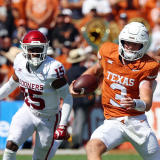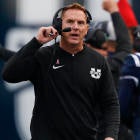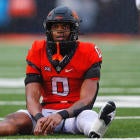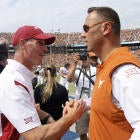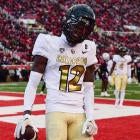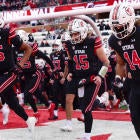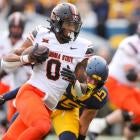The rise of college athletes feeling empowered intersected with the complicated issue of university sexual assault investigations and what defines consent.
Minnesota didn't blink at the player boycott. No bowl game? No problem.
Minnesota players decided they're going to the Holiday Bowl after all. Now it's time to educate them on what exactly they thought they were fighting for and what consent means.
The players believed due process for 10 teammates had been violated when they got suspended for their role in an alleged gang rape on Sept. 2 that resulted in no criminal charges. The accused should absolutely have rights. Minnesota would argue they did; critics of Title IX investigations, which require a lower proof of evidence than criminal cases, might think differently.
Here's a question for the players: Did they actually read the 80-page report from the university's Office of Equal Opportunity and Affirmative Action (EOAA)? Did Golden Gophers coach Tracy Claeys, caught between a rock (his administration) and a hard place (his players), read the report and understand what he was supporting with this tweet during the boycott?
Have never been more proud of our kids. I respect their rights & support their effort to make a better world! 〽️🏈
— GoldenGopherHFC (@GoldenGopherHFC) December 16, 2016
The report contains deeply disturbing and graphic details; accuses some players of misleading statements and covering their tracks; and acknowledges that the woman, who was drinking that night, expressed confusion at times about the events that occurred.
If colleges everywhere made reports like these required reading every year, maybe we could make a dent into reducing the very real problem of sexual assault on campuses. If I'm an athletic director, I would make copies of this report -- as graphic as it is -- and show it to athletes every single year.
Black and white answers to what precisely happened in the Minnesota case may never be possible. The gray area makes people uncomfortable, along with the very real fact there are cases sometimes when men are wrongfully accused of rape.
But the gray area is precisely what Minnesota is asked to sift through by the U.S. Department of Education through Title IX. Universities have their own standards for student conduct. The player boycott and Claeys' support suggested they think the standard for Minnesota player behavior is really, really, really low, or they received really, really, really bad information.
The woman told police that after a night of drinking, she initially had sex with one player that "may have been consensual" but subsequent sexual encounters with other players were not. The EOAA report issued by Minnesota said the woman thinks she had sex with 10 to 20 men.
Is this consent, as described in the EOAA report? "Several of the men had their phones out and may have been taking photos or videos. The onlookers were chanting, laughing, cheering and jostling for a position in the line to have sex with [the woman]. [The woman] remembers that the men were arguing over whose 'turn' it was to have sex with her."
What about this? "[The woman] became increasingly confused and repeatedly asked where all of the people were coming from. She repeatedly yelled at the crowd to stop sending people in the bedroom. She repeatedly yelled, 'I can't handle this many people,' and 'I don't want this to happen.' She yelled several times that she hated the onlookers, to which they laughed and someone responded, 'ha ha, why?'"
And how about this? "[The woman] recalls that, on multiple occasions, she suddenly realized what was happening to her and tried to push the men off of her. She remembers pushing men's stomachs in an attempt to get them off of her."
The police interviewed four players who said the sex was consensual. The police determined that a brief video recording showed the woman not appearing to be upset while engaging in a sexual activity. The woman later called her sister, who instructed her to go to the hospital for a rape exam.
Prosecutors may have thought they couldn't win a case and prove that a crime occurred. That doesn't end the requirements of a university to provide a safe campus for students.
Minnesota wasn't reviewing the case based on criminal standards of "beyond a reasonable doubt," which equates to roughly a 75 percent chance that the accused is responsible. It used the "preponderance of evidence standard," which requires a 50.1 percent chance that the alleged sexual assault or sexual harassment occurred in this case.
Over the past year, more than a dozen students punished over sexual assault allegations have sued schools by arguing their rights to due process were violated, according to Inside Higher Education. Two lawsuits have even gone directly at the Department of Education, which encourages colleges to use preponderance of evidence. How the courts and the incoming Donald Trump administration view Title IX investigations will be closely watched.
In the Minnesota case, the school didn't always trust what they heard from the players. The EOAA report said the accused players provided "different information from one another about key and notable facts. At times, the accused students provided information that contradicted their own reports to EOAA."
The report said there was "some degree of a collective, defensive effort to conceal relevant evidence by the accused students and other members of the football team." One player, who was not accused, told EOAA he encouraged teammates to erase their group messages from that day when they communicated about the sexual encounters. One player, who was accused, told EOAA, "I wish she didn't remember my damn name."
The woman's account of the assault has "become more detailed as time has passed," the report said. "For the most part, we found her accounts to be relatively consistent over time, even though they generally increased in detail. We generally attribute the differences among [the woman's] accounts over time to be gradual recollection of what she found to be a very traumatic experience, rather than to a lack of care or truthfulness."
In one instance, the report said, she notified the school about misidentifying a player. EOAA said doing so "demonstrates her willingness to admit that she initially remembered something incorrectly, despite the fact that such an admission could call her general credibility into question. We also found [the woman] to carefully differentiate between men who she believes may have been [in the apartment] because they appear familiar and those men who she specifically recalls being present."
Imagine what could be accomplished to reduce sexual assault if the most prominent people on campus -- the high-profile athletes and coaches -- don't solely and instinctively rally around their program. The next time an entire football team initially stands up for a woman may be the first.
Earlier this week, Minnesota players read a statement that made no mention of the woman whatsoever. Their statement included how they wanted to meet with the board privately to discuss "how to make our program great again," as if this is only about the success of an 8-4 football team.
Perhaps the boycotting Minnesota players now understand they need to choose causes carefully, even when defending teammates they know. More importantly, maybe they're learning about consent. By Saturday, Golden Gophers players finally acknowledged the woman in their statement to the Minneapolis Star Tribune that said in part:
"We now ask that you, the member of the media, our fans, and the general public hold all of us accountable for ensuring that our teammates are treated fairly, along with any and all victims of sexual assault. ... Our thoughts and prayers are for the well-being of the woman involved in the original incident, and for our 10 teammates to ensure that they are treated fairly. We look forward to representing the University of Minnesota and the state of Minnesota in the Holiday Bowl in a way that makes all of you proud."
The Holiday Bowl goes on. We knew it would. Bowl games don't go dark given the money at stake.
Let's hope the players' education about consent continues, too.



